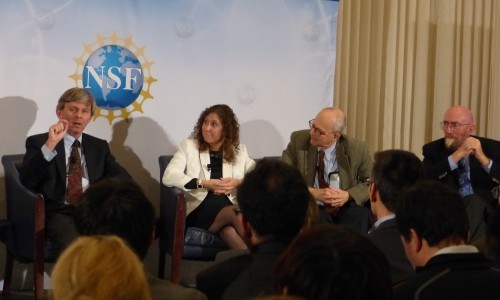
LIGO leaders at the press conference (from left): executive director David Reitze, spokesperson Gabriela González, Rai Weiss and Kip Thorne.
By Margaret Harris at the AAAS meeting in Washington DC
Not with a bang, but a chirp.
That’s how the 2016 meeting of the American Association for the Advancement of Science (AAAS) kicked off on Thursday, thanks to the spectacular news that the Laser Interferometer Gravitational-wave Observatory (LIGO) has, for the first time ever, directly observed the ripples in space–time known as gravitational waves. As our news story explains, LIGO’s twin interferometers picked up the waveform produced as two black holes spiralled into each other, emitting gravitational waves at frequencies and amplitudes that rose sharply with time, like the chirp of a cricket.
The LIGO researchers announced their discovery at a packed press conference in downtown Washington, DC. The excitement in the room was palpable, even though, as it turned out, most of the journalists present already knew what they were about to hear. This actually isn’t unusual. It’s common practice for scientific journals to send new research papers to journalists a few days ahead of publication; the idea behind this so-called embargo system is that it gives journalists time to report accurately on complex science stories.
What was unusual was that this time, there was no embargoed paper. Instead, there was a vigorous rumour mill casting out information in a messy, somewhat underhand and highly anisotropic way. This is rather interesting, and I wish that LIGO’s Gabriela González hadn’t dismissed the journalist who asked about it with an incredulous “The facts are so beautiful – why do you talk about rumours?”
The thing is, while the existence of gravitational waves (and their tremendous potential as a tool for observing the universe) is definitely the most important scientific story here, there is also a noteworthy narrative bubbling along in the background about openness, transparency and the scientific process.
My own take on this part of the LIGO story is that some degree of secret-keeping can be beneficial for science. Few would argue that the LIGO team should have gone public with its results back in September, when the inspiralling-black-hole binary signal was observed. The researchers had a lot of careful checking to do first; in particular, they had to make sure the signal wasn’t a “blind injection” – a fake event created by scientists within the collaboration to test their analysis procedures. Their caution may also have been influenced by two recent and very high-profile duds: the “detection” of primordial gravitational waves by the BICEP2 experiment in 2014 and the “faster than light” neutrinos that turned up (or, rather, didn’t) in OPERA’s detectors back in 2011. It is significant that, unlike those earlier findings, this one has gone through a formal peer-review process.
At some point, though, scientific secrecy stops being useful. In fact, it stops being possible. There are 1004 names on LIGO’s discovery paper, and no 1004 people on Earth could keep a discovery this big a secret for long. (Recall that even the Manhattan Project leaked like a sieve, despite tight security and immeasurably higher stakes.) So why try to maintain the fog of pseudo-secrecy that has hung over the LIGO result for the past several weeks?
The reason, I think, has very little to do with science. The universe does not care what we know about it, much less when. But scientists are human. Like all of us, they enjoy a bit of excitement, and when they’ve done something big and important, they want to be the centre of attention.
This is all part of human nature, and I don’t begrudge them their moment of glory. Indeed, I’d be lying if I said I didn’t enjoy the drama of this morning’s announcement, and speaking personally, this has already been the most exciting AAAS conference I’ve attended since 2001, when I and other conference-goers witnessed the release of the first draft of the human-genome sequence. But even so, I think it’s important to point out that, sometimes, scientific events happen for human reasons. And there’s no need to keep that a secret.
Trackback: Blog - physicsworld.com
Trackback: Blog - physicsworld.com